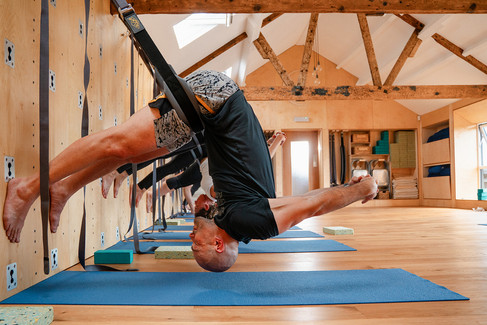The 5 Elements of Yoga and How They Shape Your Practice
- Els Kenney
- Jun 23
- 3 min read
Updated: Jul 30
At YogaOne, our classes are about more than just movement — they’re a way to reconnect with yourself and the natural world around you. One of the most fascinating concepts that threads through yogic philosophy is the idea of the five great elements: Earth, Water, Fire, Air, and Space.
These elements aren’t just ancient ideas — they directly influence how we feel, move and experience our practice. In Iyengar Yoga, each group of postures taps into these elements to bring balance, clarity and vitality to both body and mind.
Here’s how the five elements weave through your time on the mat.
Earth 🌱
Grounding. Strength. Stability
The earth element represents stability, steadiness and structure. It’s about feeling firmly rooted, both physically and emotionally.
In your practice:
You’ll connect with the earth element through standing postures — poses like Tadasana (Mountain Pose) and Virabhadrasana (Warrior Pose). These foundational shapes teach you how to stand squarely on two feet, extend through the limbs, encourage concavity of the spine and develop physical, mental and emotional stability.
Why it matters:
Standing postures build strength, stamina and resilience. They provide a grounded base for more complex movements and help calm anxiety, steady the mind and strengthen your connection to the here and now.
→ New to standing postures? Discover what to expect in an Intro Level Iyengar Yoga class here.
💧 Water
Fluidity. Adaptability. Release.
Water represents softness, surrender and the ability to let go. It teaches us how to move with grace and ease, finding calm where we might usually resist.
In your practice:
You’ll experience water through forward bends — poses that soften the body, quiet the nervous system and invite introspection. These shapes release tension in the back, hips and hamstrings while calming the mind.
Why it matters:
Forward bends relieve stress, improve flexibility and encourage a gentle inward focus. They’re essential in restoring emotional balance and releasing stored tension.
🔥 Fire
Energy. Vitality. Courage.
Fire symbolises transformation, strength and heat. It fuels action, willpower and the courage to face challenge.
In your practice:
You’ll tap into fire through backbends — postures like Ustrasana (Camel Pose) and Urdhva Dhanurasana (Upward Bow Pose). These invigorating shapes open the chest, energise the spine and stimulate the nervous system.
Why it matters:
Backbends lift mood, combat fatigue and build emotional resilience. They develop confidence, flexibility and strength in both body and spirit.
🌬️ Air
Lightness. Movement. Focus.
Air represents freedom, lightness and subtle movement. It encourages mental clarity and balance, particularly in moments of instability.
In your practice:
You’ll encounter air through balancing postures like Vrksasana (Tree Pose) and Ardha Chandrasana (Half Moon Pose). These poses challenge your concentration, strengthen stabilising muscles and teach you how to find calm in motion.
Why it matters:
Balancing postures improve focus, coordination and emotional steadiness, sharpening your ability to stay composed under pressure.
🌌 Space
Stillness. Expansion. Awareness.
Space (or Ether) is the subtlest of the five elements — the container for all others. It represents openness, clarity and the quiet between movements.
In your practice:
You’ll experience space through inversions such as Salamba Sarvangasana (Shoulderstand) and supported poses using our unique Great Yoga Wall. These postures bring stillness, perspective and profound calm.
Why it matters:
Inversions calm the nervous system, improve circulation and encourage mental clarity. They remind us to pause, expand our awareness and view life from new angles.

How We Structure Classes at YogaOne
Every class at YogaOne, whether Intro Level, Level One or Level Two, follows a careful progression. We prepare the body gradually, building towards a peak pose — the most demanding posture of the session — before gently bringing the system back down.
This approach works with the nervous system, activating and then calming, creating balance and a sense of renewal. It’s also how the different elements naturally weave through each class, leaving you feeling grounded, energised, open and at ease.

Experience the Five Elements of Yoga in Your Practice
At YogaOne, we integrate these elemental principles into every class, whether consciously or intuitively. It’s why students leave our studio feeling steadier, lighter and more alive.
Curious to experience it yourself?





















